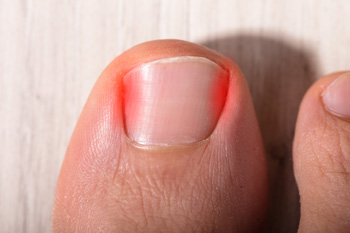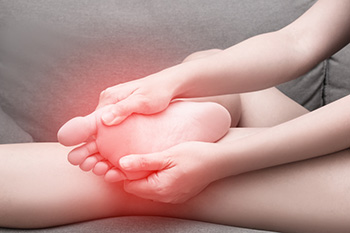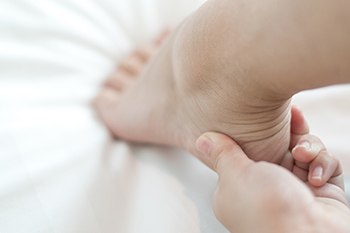
Having an ingrown toenail is annoying and painful, but it can be preventable. When the side of a toenail becomes engulfed by the skin around it, pressure can build up and cause pain. Typical signs of an ingrown toenail include redness and swelling, pain when touched, or hardened skin next to the nail. If the area gets infected, it may become filled with pus and cause bleeding. Causes of ingrown toenails include tight fitting shoes, toenails cut incorrectly or not at all, and poor foot hygiene. Home prevention techniques include cutting toenails straight across, keeping your feet clean and dried, and wearing shoes that fit properly. Anyone who has diabetes, poor peripheral circulation, or other systemic conditions that affect the feet should seek the care of a podiatrist regularly. In cases of a badly ingrown toenail, it is strongly suggested that you consult a podiatrist. Possible treatment may call for partial or complete removal of the nail to prevent further complications.
Ingrown toenails may initially present themselves as a minor discomfort, but they may progress into an infection in the skin without proper treatment. For more information about ingrown toenails, contact Leonora Fihman, DPM of California. Our doctor can provide the care you need to keep you pain-free and on your feet.
Ingrown Toenails
Ingrown toenails are caused when the corner or side of a toenail grows into the soft flesh surrounding it. They often result in redness, swelling, pain, and in some cases, infection. This condition typically affects the big toe and may recur if it is not treated properly.
Causes
You are more likely to develop an ingrown toenail if you are obese, have diabetes, arthritis, or have any fungal infection in your nails. Additionally, people who have foot or toe deformities are at a higher risk of developing an ingrown toenail.
Symptoms
Some symptoms of ingrown toenails are redness, swelling, and pain. In rare cases, there may be a yellowish drainage coming from the nail.
Treatment
Ignoring an ingrown toenail can have serious complications. Infections of the nail border can progress to a deeper soft-tissue infection, which can then turn into a bone infection. You should always speak with your podiatrist if you suspect you have an ingrown toenail, especially if you have diabetes or poor circulation.
If you have any questions, please feel free to contact our offices located in Encino and Brentwood, Los Angeles, CA . We offer the newest diagnostic and treatment technologies for all your foot care needs.

The plantar fascia is a connective band of tissue linking the heel with the toes. Since it is located on the bottom of the foot and is constantly used while standing, walking, running, and jumping, it may become torn, irritated, and swollen from overuse. The medical term for this condition is plantar fasciitis and it is the most common form of heel pain. Pain from plantar fasciitis is usually at its worst first thing in the morning after the plantar fascia has tightened overnight. After walking around and warming the body up, the pain typically subsides only to return later in the day. Because it can be caused by walking, running, and doing repetitive movements, plantar fasciitis has been nicknamed policeman’s heel, runner’s heel, and tennis heel. People who are elderly, obese, or work on their feet all day are more susceptible to acquiring this condition. Additionally, people who have high arches, flat fleet, or certain medical conditions are more at risk. Podiatrists have extensive experience and several effective methods for treating plantar fasciitis because it is so common. If you believe you have this condition, it is advised to make an appointment with a podiatrist who can provide a proper diagnosis, followed by starting correct treatment techniques.
Plantar fasciitis is a common foot condition that is often caused by a strain injury. If you are experiencing heel pain or symptoms of plantar fasciitis, contact Leonora Fihman, DPM from California. Our doctor can provide the care you need to keep you pain-free and on your feet.
What Is Plantar Fasciitis?
Plantar fasciitis is one of the most common causes of heel pain. The plantar fascia is a ligament that connects your heel to the front of your foot. When this ligament becomes inflamed, plantar fasciitis is the result. If you have plantar fasciitis you will have a stabbing pain that usually occurs with your first steps in the morning. As the day progresses and you walk around more, this pain will start to disappear, but it will return after long periods of standing or sitting.
What Causes Plantar Fasciitis?
There are some risk factors that may make you more likely to develop plantar fasciitis compared to others. The condition most commonly affects adults between the ages of 40 and 60. It also tends to affect people who are obese because the extra pounds result in extra stress being placed on the plantar fascia.
Prevention
There are a variety of treatment options available for plantar fasciitis along with the pain that accompanies it. Additionally, physical therapy is a very important component in the treatment process. It is important that you meet with your podiatrist to determine which treatment option is best for you.
If you have any questions, please feel free to contact our offices located in Encino and Brentwood, Los Angeles, CA . We offer the newest diagnostic and treatment technologies for all your foot care needs.

Anyone who runs for exercise or sports, such as track and soccer, knows that injury to their feet and ankles are bound to occur at some point. The most common injuries happen as a result of overuse. Among them are plantar fasciitis (heel pain), Achilles tendonitis (back of the ankle pain), sesamoiditis (pain at the base of the toes), and stress fractures (frequently in the metatarsal bones). By far, the most common of these is plantar fasciitis, caused by inflammation of the band of tissue that holds up the arch on the foot. Some relief can be provided by stretching exercises, resting and icing the area, and finding shoes with better arch support. Pain in the back of the heel, generally caused by an inflamed Achilles tendon, is a common sign of overuse, especially among beginners who run too far, too fast. Rest, ice, compression and elevation may help, along with stretching exercises, and possibly orthotics. Pain, burning, and swelling in the ball of the foot can be caused by a pinched nerve or inflammation in the metatarsal joints. Orthotics and different running shoes can help. Stress fractures are difficult to detect and slow to heal, but cause ongoing discomfort. For help with any of these common injuries, it is best to consult with a podiatrist who can do a thorough examination and provide proper treatment options depending on the diagnosis.
Sports related foot and ankle injuries require proper treatment before players can go back to their regular routines. For more information, contact Leonora Fihman, DPM of California. Our doctor can provide the care you need to keep you pain-free and on your feet.
Sports Related Foot and Ankle Injuries
Foot and ankle injuries are a common occurrence when it comes to athletes of any sport. While many athletes dismiss the initial aches and pains, the truth is that ignoring potential foot and ankle injuries can lead to serious problems. As athletes continue to place pressure and strain the area further, a mild injury can turn into something as serious as a rupture and may lead to a permanent disability. There are many factors that contribute to sports related foot and ankle injuries, which include failure to warm up properly, not providing support or wearing bad footwear. Common injuries and conditions athletes face, including:
Sports related injuries are commonly treated using the RICE method. This includes rest, applying ice to the injured area, compression and elevating the ankle. More serious sprains and injuries may require surgery, which could include arthroscopic and reconstructive surgery. Rehabilitation and therapy may also be required in order to get any recovering athlete to become fully functional again. Any unusual aches and pains an athlete sustains must be evaluated by a licensed, reputable medical professional.
If you have any questions please feel free to contact our offices located in Encino and Brentwood, Los Angeles, CA . We offer the newest diagnostic and treatment technologies for all your foot and ankle needs.

Some children are born with a condition known as metatarsus adductus, which is a turning inward of the feet. The inside of the foot appears caved in and the outside more rounded. While it may be alarming to look at, this condition generally diminishes in a few years. Although no cause has been determined for metatarsus adductus, some experts believe it to be a result of the fetus being tightly packed inside the uterus before birth. The metatarsus is a collection of bones in the midfoot, known as the five metatarsals. These bones connect the toes to the heel. A podiatrist can properly examine your baby’s feet and determine which form of metatarsus is present. In flexible metatarsus, the foot can be straightened manually, and some stretching exercises may help. The condition may continue until the child is between 1 and 2 years old. In non-flexible metatarsus, the foot stays in a curved position. In this case, fittings for braces and special shoes may be required. In rare cases, surgery to reposition the foot may be suggested. A podiatrist can monitor your child’s case and prescribe appropriate treatment.
The health of a child’s feet is vital to their overall well-being. If you have any questions regarding foot health, contact Leonora Fihman, DPM of California. Our doctor can provide the care you need to keep you pain-free and on your feet.
Tips for Keeping Children's Feet Healthy
If you have any questions, please feel free to contact our offices located in Encino and Brentwood, Los Angeles, CA . We offer the newest diagnostic and treatment technologies for all your foot care needs.

Heel pain can be caused by a variety of conditions, with the most common being plantar fasciitis: an inflammation of the plantar fasciitis tissue on the bottom of the foot. Identifying where the pain is specifically located in the heel can sometimes help your podiatrist diagnose your condition. For instance, plantar fasciitis usually causes pain in the bottom/middle of the heel which is at its worst when you first wake up in the morning. Other conditions, such as heel stress fractures, nerve issues, or heel pad atrophy can also cause pain on the bottom of the heel. Pain in the back of the heel may be caused by problems with your Achilles tendon, which connects the heel bone to the calf muscles. These conditions include Achilles tendinopathy/tendinitis, which is usually an overuse injury to the tendon, Haglund’s deformity, which produces a bump at the back of the heel due to shoes exerting pressure on the tendon, and Sever’s disease, which is due to stress on the heel’s growth plate in growing children. Pain in the middle of the heel can sometimes be caused by an entrapped nerve in the ankle (tarsal tunnel syndrome). Sinus tarsi syndrome, typically due to flat feet or following an ankle sprain, can cause pain in the middle/side portion of the heel. Any type of heel pain should be examined by a podiatrist to receive proper diagnosis and treatment.
Many people suffer from bouts of heel pain. For more information, contact Leonora Fihman, DPM of California. Our doctor can provide the care you need to keep you pain-free and on your feet.
Causes of Heel Pain
Heel pain is often associated with plantar fasciitis. The plantar fascia is a band of tissues that extends along the bottom of the foot. A rip or tear in this ligament can cause inflammation of the tissue.
Achilles tendonitis is another cause of heel pain. Inflammation of the Achilles tendon will cause pain from fractures and muscle tearing. Lack of flexibility is also another symptom.
Heel spurs are another cause of pain. When the tissues of the plantar fascia undergo a great deal of stress, it can lead to ligament separation from the heel bone, causing heel spurs.
Why Might Heel Pain Occur?
Treatments
Heel pain should be treated as soon as possible for immediate results. Keeping your feet in a stress-free environment will help. If you suffer from Achilles tendonitis or plantar fasciitis, applying ice will reduce the swelling. Stretching before an exercise like running will help the muscles. Using all these tips will help make heel pain a condition of the past.
If you have any questions please contact our offices located in Encino and Brentwood, Los Angeles, CA . We offer the newest diagnostic and treatment technologies for all your foot and ankle needs.
 Walking and running are two completely different activities that impact different parts of the feet. Research has shown it is beneficial to wear shoes that can complement different running and walking styles. One of the differences between the two types of shoes has to do with the type of sole. Running shoes have stiffer and sturdier soles than walking shoes. This is helpful in providing the necessary stability while running. Proper walking shoes have a flexible sole, and the heels tend to be heavier than those of running shoes. Additionally, the shoes are made of different materials. Running shoes are made of breathable fabrics, which can help when feet become sweaty. A portion of the shoe that is referred to as the counter can help provide a secure fit. In walking shoes, the heel is tilted, and the toe area is stiff. Please confer with a podiatrist who can provide you with more information about the differences between walking and running shoes.
Walking and running are two completely different activities that impact different parts of the feet. Research has shown it is beneficial to wear shoes that can complement different running and walking styles. One of the differences between the two types of shoes has to do with the type of sole. Running shoes have stiffer and sturdier soles than walking shoes. This is helpful in providing the necessary stability while running. Proper walking shoes have a flexible sole, and the heels tend to be heavier than those of running shoes. Additionally, the shoes are made of different materials. Running shoes are made of breathable fabrics, which can help when feet become sweaty. A portion of the shoe that is referred to as the counter can help provide a secure fit. In walking shoes, the heel is tilted, and the toe area is stiff. Please confer with a podiatrist who can provide you with more information about the differences between walking and running shoes.
For more information about walking shoes versus running shoes, consult with Leonora Fihman, DPM from California. Our doctor can measure your feet to determine what your needs are and help you find an appropriate pair of footwear.
Foot Health: The Differences between Walking & Running Shoes
There are great ways to stay in shape: running and walking are two great exercises to a healthy lifestyle. It is important to know that running shoes and walking shoes are not interchangeable. There is a key difference on how the feet hit the ground when someone is running or walking. This is why one should be aware that a shoe is designed differently for each activity.
You may be asking yourself what the real differences are between walking and running shoes and the answers may shock you.
Differences
Walking doesn’t involve as much stress or impact on the feet as running does. However, this doesn’t mean that you should be any less prepared. When you’re walking, you land on your heels and have your foot roll forward. This rolling motion requires additional support to the feet.
Flexibility – Walking shoes are designed to have soft, flexible soles. This allows the walker to push off easily with each step.
If you have any questions, please feel free to contact our offices located in Encino and Brentwood, Los Angeles, CA . We offer the newest diagnostic and treatment technologies for all your foot care needs.
Arthritis, a painful inflammatory condition, can affect many parts of the body including the feet, particularly as you age. Arthritic foot pain often comes with stiff joints, as well as a loss of strength, flexibility, and mobility in the affected area. Various things can be done to relieve pain and slow the progression of this disease, including foot massages to improve circulation and decrease tension in the joint, using heat (to loosen the muscles and reduce stiffness), or using ice (to constrict blood vessels and reduce blood flow to the problem area). Wearing proper footwear (wide enough to accommodate orthotics or other foot aids and with proper arch support to stabilize the joints and feet) and continuing to move despite the pain may also help. Other suggestions include maintaining a healthy body weight, participating in physical therapy, using non-steroidal anti-inflammatory medications, topical creams, and;/or steroid injections. While there is no cure for arthritis, a podiatrist can help determine the best way to handle your arthritic foot pain.
Arthritis can be a difficult condition to live with. If you are seeking treatment, contact Leonora Fihman, DPM from California. Our doctor can provide the care you need to keep you pain-free and on your feet.
Arthritic Foot Care
Arthritis is a term that is commonly used to describe joint pain. The condition itself can occur to anyone of any age, race, or gender, and there are over 100 types of it. Nevertheless, arthritis is more commonly found in women compared to men, and it is also more prevalent in those who are overweight. The causes of arthritis vary depending on which type of arthritis you have. Osteoarthritis for example, is often caused by injury, while rheumatoid arthritis is caused by a misdirected immune system.
Symptoms
Arthritic symptoms range in severity, and they may come and go. Some symptoms stay the same for several years but could potentially get worse with time. Severe cases of arthritis can prevent its sufferers from performing daily activities and make walking difficult.
Risk Factors
If you suspect your arthritis is affecting your feet, it is crucial that you see a podiatrist immediately. Your doctor will be able to address your specific case and help you decide which treatment method is best for you.
If you have any questions, please feel free to contact our offices located in Encino and Brentwood, Los Angeles, CA . We offer the newest diagnostic and treatment technologies for all your foot care needs.
Diabetes, which is a disease caused by a blood sugar imbalance, can cause problems in parts of the body, most commonly the feet, ankles, and lower legs. The problem is reduced circulation, which keeps the blood from reaching these areas. This can damage the nerves (neuropathy) and can result in numbness, tingling, pain and other discomfort. It can also slow the healing process if you have sores or cuts on the foot or ankle, which may turn into ulcers and become infected. You can prevent more serious problems by taking time each day to wash and thoroughly dry your feet, avoid going barefoot, wearing shoes that fit properly, and checking for sores and cuts. If you notice cracked skin, blisters and sores that will not heal, it is a good idea to consult a podiatrist and set up a regular plan for treatment.
Diabetic foot care is important in preventing foot ailments such as ulcers. If you are suffering from diabetes or have any other concerns about your feet, contact Leonora Fihman, DPM from California. Our doctor can provide the care you need to keep you pain-free and on your feet.
Diabetic Foot Care
Diabetes affects millions of people every year. The condition can damage blood vessels in many parts of the body, especially the feet. Because of this, taking care of your feet is essential if you have diabetes, and having a podiatrist help monitor your foot health is highly recommended.
The Importance of Caring for Your Feet
Patients with diabetes should have their doctor monitor their blood levels, as blood sugar levels play such a huge role in diabetic care. Monitoring these levels on a regular basis is highly advised.
It is always best to inform your healthcare professional of any concerns you may have regarding your feet, especially for diabetic patients. Early treatment and routine foot examinations are keys to maintaining proper health, especially because severe complications can arise if proper treatment is not applied.
If you have any questions please feel free to contact our offices located in Encino and Brentwood, Los Angeles, CA . We offer the newest diagnostic and treatment technologies for all your foot and ankle needs.
